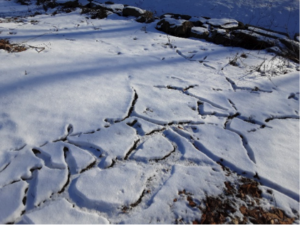 While we at Our Old House maintain a certain amount of “isolation” during this pandemic, we have walked or snowshoed our property for exercise, noting as we passed the tracks the local wildlife has made. Coyotes, deer, rabbits, bobcats, foxes, and others roam our “back forty.” I began to think about the same tracks Our Old House builder Asa Williams would have encountered in the late eighteenth century, along with the occasional bear or wolf, hopefully not in the front yard. Grizzlies on the lawn? No thanks!
While we at Our Old House maintain a certain amount of “isolation” during this pandemic, we have walked or snowshoed our property for exercise, noting as we passed the tracks the local wildlife has made. Coyotes, deer, rabbits, bobcats, foxes, and others roam our “back forty.” I began to think about the same tracks Our Old House builder Asa Williams would have encountered in the late eighteenth century, along with the occasional bear or wolf, hopefully not in the front yard. Grizzlies on the lawn? No thanks!
What do I get on my front lawn?
Mice.
I noticed the tracks as I was out walking in hopes of clearing my befuddlement concerning my family history research. In a house this old, cracks, crevices, and a few holes are common, and the local rodent population is adept at finding them. The tunnels they make under the snow look like my current family history research plan: wandering in circles with no clear destination.
I understand there are those people who have made great progress in their family history research while being cloistered. I am not one of them.
My “squirrel bins,” those havens of genealogical distractions, have already been thoroughly plundered, organized, and packed away; family files were color-coordinated long ago; online research has slowed down because I need to actually visit certain repositories for information not found online, and they are invariably closed, limited in appointments, or require hours of travel.
My “squirrel bins,” those havens of genealogical distractions, have already been thoroughly plundered, organized, and packed away...
I know I’m not alone on this plateau. I just refuse to believe that there is nothing more to be learned, nothing more to be discovered, nothing more to enjoy in the hunt for information on my ancestors’ daily lives. So I tried moving laterally in family history, researching those people who lived and worked in the communities around my reticent relatives. I’ve found squirrel bins of a different sort: online.
I’ve found distant cousins who had more adventurous lives than the farmers of closer lineage, a few sailors as well as unrelated stagecoach drivers and local storytellers. Tales of travel and reminiscences of local daily life in the early 1800s encouraged me to find out more about the people in those tales as well as their authors. References to epidemics that seem to have been written yesterday make me happy to be where I am.
I may still be somewhat befuddled (which could be my normal state of mind, sad to say), but there’s some progress. These online squirrel bins seem to be just the distraction needed!
My advice is to follow your mice . . . er . . . muse. We can never tell where their tracks will lead.
Share this:

About Jan Doerr
Jan Doerr received a B.A. degree in Sociology/Secondary Education from the University of New Hampshire, and spent a long career in the legal profession while researching her family history. She has recently written and published articles for WBUR.org’s Cognoscenti blog: “Labor of Love: Preserving a 226-Year-Old Family Home and Preparing to Let It Go” and “The Value of Family Heirlooms in a Digital Age.” Jan currently lives with her attorney husband in Augusta, Maine, where she serves two Siamese cats and spends all her retirement money propping up a really old house.View all posts by Jan Doerr →